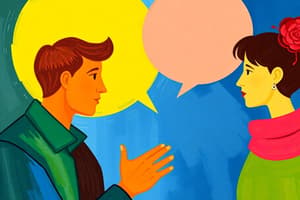Podcast
Questions and Answers
What is a common barrier to effective communication that occurs due to the complexities within an organization?
What is a common barrier to effective communication that occurs due to the complexities within an organization?
- Complex organizational structure (correct)
- Feeling of prejudice
- Misuse of language
- Lack of interest from the listener
Prejudice can enhance effective communication among individuals.
Prejudice can enhance effective communication among individuals.
False (B)
What can cause a distortion or failure of messages in an organization?
What can cause a distortion or failure of messages in an organization?
Too many levels in the organization
_______ can act as a barrier when individuals use incorrect or unfamiliar words in communication.
_______ can act as a barrier when individuals use incorrect or unfamiliar words in communication.
Match the following barriers with their descriptions:
Match the following barriers with their descriptions:
Which factor is NOT mentioned as affecting effective communication?
Which factor is NOT mentioned as affecting effective communication?
Environmental disturbances can make communication easier.
Environmental disturbances can make communication easier.
Give an example of a visual perception barrier in communication.
Give an example of a visual perception barrier in communication.
Which of the following is NOT a type of digital communication?
Which of the following is NOT a type of digital communication?
Digital communication enhances personal interaction between users.
Digital communication enhances personal interaction between users.
What is one disadvantage of digital communication related to data?
What is one disadvantage of digital communication related to data?
Digital communication allows companies to reach audiences around the world without the need for a physical __________.
Digital communication allows companies to reach audiences around the world without the need for a physical __________.
Match each type of digital communication with its primary characteristic:
Match each type of digital communication with its primary characteristic:
Which is an advantage of digital communication related to environmental impact?
Which is an advantage of digital communication related to environmental impact?
Technological dependency can lead to disruptions in digital communication.
Technological dependency can lead to disruptions in digital communication.
Name one barrier to effective communication that can arise from digital transformation.
Name one barrier to effective communication that can arise from digital transformation.
Which of the following is NOT a form of written communication?
Which of the following is NOT a form of written communication?
Non-verbal communication includes the use of words and written text.
Non-verbal communication includes the use of words and written text.
What is visual communication?
What is visual communication?
Barriers to effective communication can be defined as __________ that affect the transmission and understanding of information.
Barriers to effective communication can be defined as __________ that affect the transmission and understanding of information.
Match the following types of communication with their corresponding forms:
Match the following types of communication with their corresponding forms:
Which of the following methods is a common form of visual communication in the workplace?
Which of the following methods is a common form of visual communication in the workplace?
Gestures and eye movement are considered non-verbal signals.
Gestures and eye movement are considered non-verbal signals.
Name one barrier to effective communication.
Name one barrier to effective communication.
Flashcards
Communication Barriers
Communication Barriers
Obstacles that prevent clear and accurate communication.
Sender Deficiencies
Sender Deficiencies
Problems with the person sending the message.
Listener Deficiencies
Listener Deficiencies
Issues with the person receiving the message.
Inappropriate Communication Methods
Inappropriate Communication Methods
Signup and view all the flashcards
Organizational Barriers
Organizational Barriers
Signup and view all the flashcards
Complex Organizational Structure
Complex Organizational Structure
Signup and view all the flashcards
Too Many Organizational Levels
Too Many Organizational Levels
Signup and view all the flashcards
Language Barriers
Language Barriers
Signup and view all the flashcards
Oral Communication
Oral Communication
Signup and view all the flashcards
Written Communication
Written Communication
Signup and view all the flashcards
Non-Verbal Communication
Non-Verbal Communication
Signup and view all the flashcards
Visual Communication
Visual Communication
Signup and view all the flashcards
Digital Communication
Digital Communication
Signup and view all the flashcards
Global Reach
Global Reach
Signup and view all the flashcards
Cost Efficiency
Cost Efficiency
Signup and view all the flashcards
Data Security Risks
Data Security Risks
Signup and view all the flashcards
Technology Dependency
Technology Dependency
Signup and view all the flashcards
Lack of Personal Touch
Lack of Personal Touch
Signup and view all the flashcards
Negative Feedback Online
Negative Feedback Online
Signup and view all the flashcards
Disruptions from Digital Transformation
Disruptions from Digital Transformation
Signup and view all the flashcards
Study Notes
Unit 1: Introduction to Communication
- Communication is the sharing of information between two or more individuals, or within a group, to reach a common understanding.
- The word "communication" comes from the Latin word commūnicāre, meaning "to share."
Importance of Communication
- Connect: Building relationships
- Influence: Persuading others
- Express yourself: Sharing thoughts and feelings
- Inform: Sharing knowledge
Elements of Communication
- Sender: The person initiating the communication
- Message (Encoding): The idea, information, or feelings being conveyed
- Channel: The medium used to transmit the message (e.g., phone, email, in-person)
- Receiver: The person receiving the message
- Reply (Decoding): The receiver's response or understanding of the message
Dimensions of Communication
- Intra-personal communication: Communication with oneself.
- Inter-personal communication: Communication between two people.
- Group communication: Communication among a small group of people.
- Mass communication: Communication to a large audience.
Types of Communication
- Verbal communication: Using words.
- Oral: Spoken words.
- Written: Letters, notes, emails.
- Nonverbal communication: Communicating without words.
- Expressions
- Posture
- Gestures
- Eye contact
- Touch
- Space
- Para-language; tone of voice
- Visual communication: Using images, symbols, and signs to communicate.
Types of Visual Communication
- Info graphics
- Process Diagrams
- Flow Charts
- Roadmaps
- Charts and Graphs
- Visual Reports
Barriers to Effective Communication/Noise
- Deficiencies of the sender
- Deficiencies of the listener
- Inappropriate means of communication
Barriers to Communication
- Physical: Environmental barriers (e.g., noise) or wrong choice of medium (e.g., using a tool that doesn't work)
- Semantic: Varied meanings (e.g., slang)
- Cultural: Diversity (e.g., culture differences).
- Psychological/Attitudinal: Moods, attitudes and relationships
- Time
- Place
- Space
- Climate
- Noise
- Choice of medium
Organizational Barriers
- Complex organizational structure: Long communication channels can cause breakdowns.
- Too many levels: Messages can get distorted or lost.
- Time and timeliness: Time pressures can lead to hasty and ineffective communication.
Factors Affecting Effective Communication
- Language: Use of incorrect/unfamiliar words
- Visual Perception: Judging people/situations
- Past Experience: Letting earlier experience influence current communication.
- Prejudice: Fixed ideas.
- Feelings: Emotions influencing communication.
- Environment: Noise or disturbance.
- Personal factors: Fear, low confidence.
- Culture: Different cultural meanings to signs and symbols.
7 Cs of Effective Communication
- Completeness: Provide all necessary information
- Conciseness: Brevity without unnecessary details
- Consideration: Respect for the audience's needs, tailor message empathetically
- Concreteness: Provide specific facts and evidence.
- Correctness: Ensure accuracy in words and information.
- Clarity: Easy to understand without ambiguity; ensure message easily understood
- Courtesy: Respectful and polite communication
Significance of English Language
- One of the most widely spoken languages globally, used in over 118 countries
- Language of commerce, science, aviation and more!
- Common communication channel across international borders
Digital Communication
- Electronic exchange of data or information via online tools (emails, social media, etc.)
- Replacing traditional modes of communication
- Importance continues to grow with technological advancements
Importance of Digital Communication
- Global reach: Reach audiences worldwide without physical presence
- Cost efficiency: Offers higher return on investment
- Collaborative working: Facilitation of team projects across multiple locations
- Environmental impact: Reduced paper usage
- Security and privacy: Users can control who has access to their information.
- Flexibility and adaptability: Adaptable to changing conditions
Types of Digital Communication
- Instant messaging and live chat
- Websites and blogs
- SMS/text messaging
- Phone calls and voicemail
- Video
Disadvantages of Digital Communication
- Data security: Increased cybersecurity risks as companies share more data
- Technology dependency: Technological errors interrupting message transfer
- Lack of personal touch: Reduced in-person interaction
- Complexity: Increased complexity with evolving technology
- Negative feedback: Unanswered negative comments causing issues
- Distractions: Excessive social networking impeding productivity
- Disruption to Employees: Difficulty adapting to new technologies and ways of communicating
Advantages of Digital Communication
- Compression: Compressing data into smaller packages
- Reliability: Increased reliability of transmission
- Cost: Cheaper than traditional forms of communication
- Speed: Faster transfer of communication
- Security: Added security measures to input signals
- Convenience: Controlling communication timing
- Collaboration: Seamless teamwork regardless of location
- Customer Experience: Easy to communicate with clients on their terms
Tips for Effective Digital Communication
- Identify goals.
- Understand the situation.
- Gain insights into the target audience
- Select appropriate digital communication tools.
- Develop your communication strategy.
Studying That Suits You
Use AI to generate personalized quizzes and flashcards to suit your learning preferences.
Related Documents
Description
This quiz covers the foundational concepts of communication, including its definition, importance, elements, and dimensions. Gain insights into how communication facilitates connection and understanding between individuals and groups.




